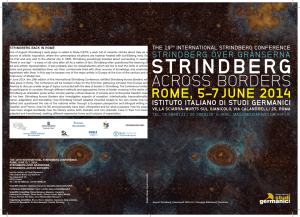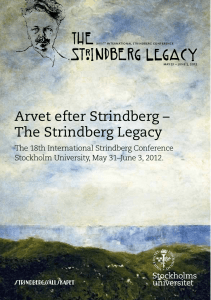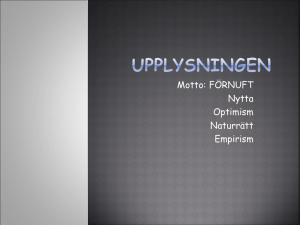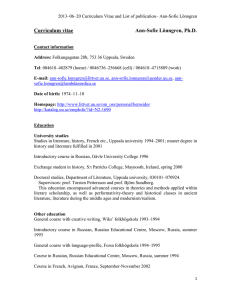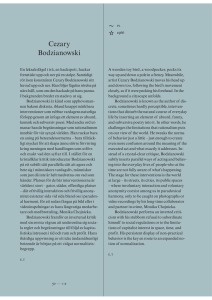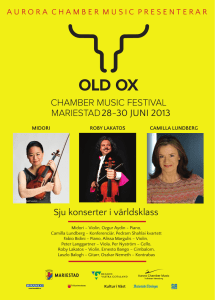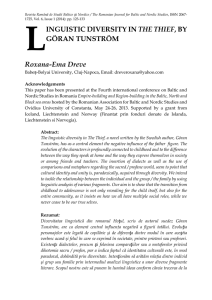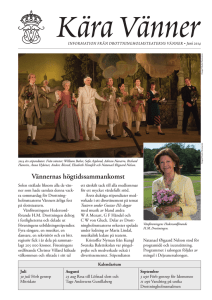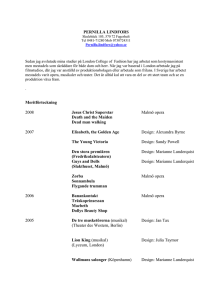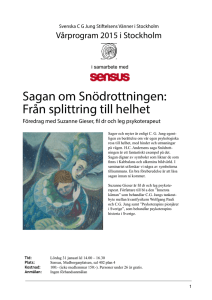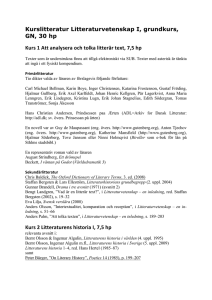Strindberg över gränserna / Strindberg Across
advertisement
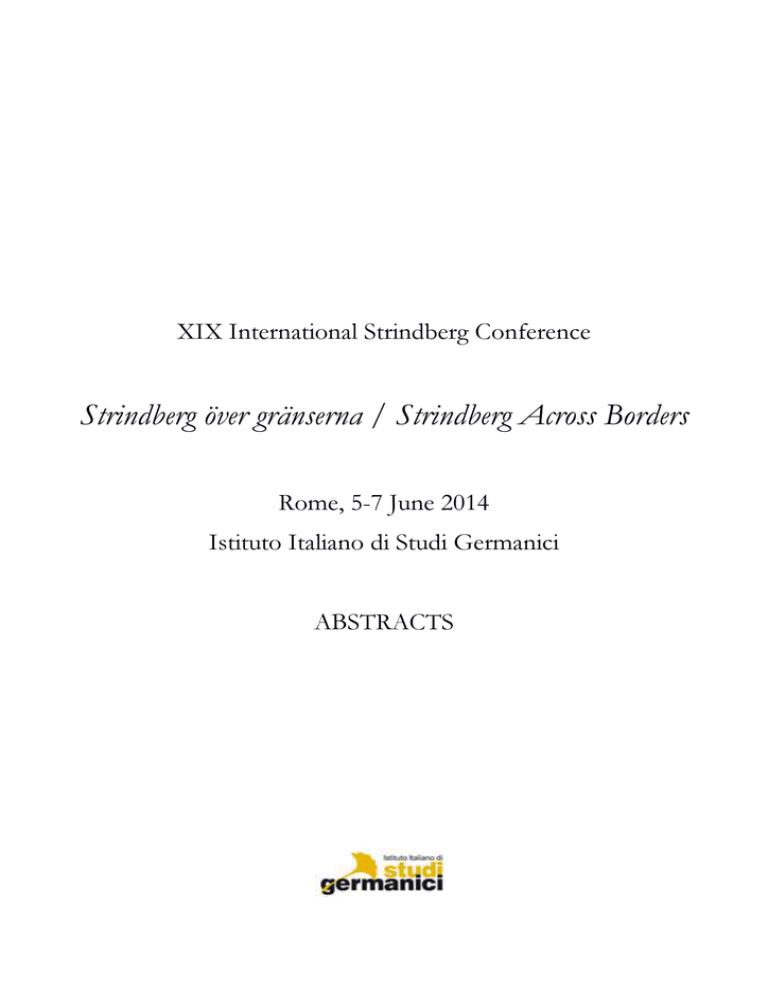
XIX International Strindberg Conference Strindberg över gränserna / Strindberg Across Borders Rome, 5-7 June 2014 Istituto Italiano di Studi Germanici ABSTRACTS Jan Balbierz, Jagiellonian University, Krakow Vid kanons gränser. Strindberg och Ekelöf om litterära föregångere Frågeställningarna kring litterära föregångare och den kulturella kanons gränser är centrala för Strindbergs författarskap både före och efter Inferno-krisen. Hans relation till det förflutna är alltid komplicerad och mångbottnad: dels tänjer och ifrågasätter han gränserna till sekelskiftets litterära kanon och genomför – med Harold Blooms terminologi – ett ständigt agon med andra starka författare; dels försöker han alltid skriva in sig i den kulturella traditionen och bekräfta sin egen estetik och ideologi genom att hänvisa till tidigare författare. I mitt paper vill jag diskutera Strindbergs förhållande till den litterära kanon och hans försök till nya gränsdragningar men samtidigt visa vad som händer när han själv börjar fungera som stark föregångare – detta med Gunnar Ekelöfs Strindbergsläsningar som exempel. Ekelöf var under hela sitt liv entusiastisk Strindbergian, hans läsningar satte sina spår såväl i de poetiska texterna som i essäerna. Jag vill undersöka på vilket sätt Ekelöf konstruerar Strindberg som litterär föregångare, hur han kommenterar Strindbergs texter och ingår i dialog med honom. Jag kommer också att diskutera likheterna mellan Strindbergs och Ekelöfs uppfattningar om den kulturella kanon, deras citeringspolitik, traditionsvärnandet och letandet efter ingångar till den delen av den litterära traditionen som är förankrad i drömmar och visioner. Elena Balzamo, litteraturhistoriker, essäist och översättare, Chartres “Jag är arg som en broms…” – Strindberg och passionerna Under 1800-talet genomgår begreppet “passion” en grundlig omvälvning. Efter att ha hyllats av romantikerna och betraktats som ett väsentligt känslodrag hos den manliga karaktären, både den poetiska och den heroiska, fick det så småningom en alltmer påtaglig negativ innebörd, som ett utpräglat kvinnlig karaktärsdrag, ofta med bismak av hysteri och en allmänt sjuklig läggning. I Strindberg möter man ett invecklat fall, där strävan att framstå som stark, behärskad, manlig ständigt blir ifrågasatt. I omgivningens och kritikens ögon betraktas han som ombytlig, otyglad, oförmögen att behärska sina känslor. En kritik som hans skrifter också drabbas av. Själv är han väl medveten av affekternas roll för sitt skrivande och för att bemöta kritiken och även berättiga sitt tillvägagångssätt i sina egna ögon utvecklar han en högst intressant argumentation vars syfte är att skaffa positivistiska, “naturvetenskapliga” anledningar till de egna affekterna och att framhäva motsättningen mellan dessa och de “negativa” affekter som han tillskriver kvinnorna och vissa av sina manliga motståndare. Mycket står på spel i dessa försök: objektivitet, poetisk inbillningskraft, intellektuell (in)konsekvens, handlings(o)förmåga – allt detta tematiseras både i hans brev och i hans övriga skrifter, litterära, polemiska och vetenskapliga. I mitt inlägg ämnar jag analysera Strindbergs förhållande till affekterna och urskilja dess viktigaste utvecklingslinjer. 2 Richard Bark, Fil.dr, operaregissör, pensionerad universitetslektor Strindberg – Back Stage: Vad sker “utanför” scenrummet i några Strindbergsdramer? Här görs ett försök att se på vilket sätt scenografin i ett antal dramer är en aktiv medspelare i dramat, ofta gestaltande dramats konflikt. Inte minst fokuseras på det som sker utanför själva scenen och hur detta påverkar dramat i dess helhet. Strindberg laborerar ofta med en “inre” scen, inte minst för att gestalta det som sker i människornas inre. Han spränger scenrummet. Begrepp som fiktionsplansväxlingar, förvandlingar, upphävande av tid och rum, pjäser i pjäsen kommer att användas. Inlägget illustreras med skisser över hur Strindberg kan ha tänkt sig scenrummens utformning. Annie Bourguignon, University of Lorraine Den Okände och det okända. Var går gränsen mellan Strindberg och “makterna”? Det övernaturliga väsen som jag-berättaren konfronteras med i Légendes/Legender kallas för “l’Inconnu/den Okände”. Han är en modern motsvarighet till den ängel som Jakob brottas med i Bibeln, alltså till “Gud” eller “makterna”. I Till Damaskus har “Den Okände” blivit namnet till huvudgestalten – vilken framstår tydligt som författarens dubbelgångare. Att Den Okände i dramat har fått sitt namn efter namnet till Gud i Legender har tolkats som försoningstecken och hänvisning till personens helt förändrade förhållande till makterna. Men det för även tanken till frågan om inte gestalten delvis identifieras med makterna. Till Damaskus kännetecknas av att dramat inte längre har självständiga dramatis personae, och personerna framställs uteslutande från huvudpersonens synvinkel. Strängt taget har dramat inga “personer”, utan det är ett “monodrama” – som det ibland har kallats. Utanför huvudgestaltens inre värld finns ingen objektiv verklighet, eller också kan en sådan verklighet inte alls uppfattas av gestalten/författaren. Men hur förhåller det sig med “makterna” – som definieras bland annat som “den Osynlige” – när “de andra” inte är annat än subjektiva bilder hos det enda subjektet som kan tänkas? Att Den Okände i Till Damaskus är författare, skapare, gör honom både till en “syndare” som ska straffas för att han vill bli lik Gud och därmed påminnas om att han inte är det, och en som ikläder sig Guds roll. I Legender och Till Damaskus blir gränsen mellan jaget och “makterna” än tydlig än suddig. Jag ämnar undersöka om och i vilken mån denna labila gräns bidrar till texternas mångtydighet. Cecilia Carlander, Södertörn University Strindberg och det androgyna Det europeiska sekelskiftet 1900 är en förändringarnas tid som ger upphov till osäkerhet på olika håll. Normer och traditioner ifrågasätts och utvecklingen av könsrollerna påverkar stämningen. I litteraturen uttrycks detta bland annat genom dekadenta stämningar som kännetecknas av bland annat oro, tvivel och ambivalens. En ambivalensens figur, tätt knuten till de nya könsrollerna, är androgynen, som likaså kan ses som en typisk dekadensfigur, trots att androgynen i sig, precis som Mircea Eliade 3 påpekat, 1 är en vida tids- och platsmässigt spridd figur. Samtidigt som androgynen uttrycker ambivalens, oro eller en gåtfullhet, ses figuren bland dekadenterna som en mänsklighetens dröm befriad från det sexuella, och den representerar ett ideal genom att båda könen smälts samman inom den.2 Hos Strindberg, som var mycket lyhörd för sin tids stämningar och förändringar, finns det förstås några figurer som är mer eller mindre besläktade med androgynen. Det är några av dessa figurer som jag tänker koncentrera mig på i min presentation, eftersom de kan dels sägas stå för ett gränsöverskridande i sig själva, dels förknippas med den större mer övergripande dekadenslitteraturen, som även den är gränsöverskridande. På så vis kan jag undersöka Strindbergs gränsöverskridanden på två plan. I mitt bidrag tänker jag titta närmare på Helène och Albert i “Mot betalning” (Giftas II, 1886), Axel Borg i I havsbandet (1890) samt Esther och Max i Götiska rummen (1904). Massimo Ciaravolo, University of Florence Strindberg and the Scandinavian political radicalism of the 1880s seen through his relationship with Branting, E. Brandes and Bjørnson Strindberg’s strategies of commitment, disengagement and new commitment across the border between literature and politics represent an intriguing intellectual adventure we can follow throughout his life as a writer. In my paper I would like to focus on Strindberg’s dilemma especially as it took form in the first half of the 1880s, and observe it through his fundamental and controversial relation to the Swedish journalist, literary critic, and Social-democratic politician and leader Hjalmar Branting; to the Danish playwright, literary critic, journalist and radical liberal politician Edvard Brandes; and to the Norwegian writer, politically engaged intellectual and nasjonalskald Bjørnstjerne Bjørnson. At least for a certain period they all experienced, as Strindberg did, working in a field where art and politics were intertwined and, to a certain extent, part of the same project, and each of them interpreted this ambivalence in a different way. For Strindberg the writer, defending his autonomy from the political field became crucial in the end. What did his colleagues expect of his work? How did Strindberg react to their expectations? What is his legacy today with respect to stances such as the intellectual autonomy from power, the criticism of civilization, pacifism, anti-feminism and anti-Semitism? Tobias Dahlkvist, Stockholm University Strindberg och Lombroso. Eller Strindberg som vansinnigt geni I mitten av 1800-talet började medicinen intressera sig för frågan om geniet som en patologisk avvikelse. Att geni är besläktat med vansinne är förvisso en tanke med rötter 1 Mircea Eliade, Mythes, rêves et mystères, Paris, Gallimard, 1957, p. 12. 2 Jean Pierrot, L’Imaginaire décadent, Rouen, Presses Universitaires de Rouen, 2007, (1977), p. 167: «Il [l’androgyne] signifie le rêve d’une humanité débarrassée de la sexualité par l’apparition d’un être idéal en lequel se fondraient les deux sexes.» 4 i den grekiska antiken, som under århundradena tagit sig kraftfulla uttryck i exempelvis renässansens melankoliintresse och romantikens kult av geniets irrationella, mot vansinnet vettande sidor. Men under 1800-talet kom läkarvetenskapen, först genom en rad franska psykiatriker (Lélut, Réveille-Parisé, Moreau de Tours), att ta frågan om geniet var en form av vansinne på största allvar. Det viktigaste namnet i denna märkliga vetenskapliga tradition var italienaren Cesare Lombroso, kriminalantropologins fader och vid sekelskiftet 1900 sannolikt den mest inflytelserika av alla vetenskapsidkare. Lombroso gav från 1864 ut inte mindre än fyra böcker, i vilka han gradvis alltmer uttalat diskuterar geniet som en form av sjukdom: en form av dold epilepsi, närmare bestämt. I Lombrosos efterföljd skrevs en lång rad fallstudier över förment sjukliga författare, så kallade patografier. Dostojevskij och Rousseau, Schopenhauer och Nerval blev alla föremål för sådana studier. Strindberg läste med stor iver både Lombroso och en rad av hans lärjungar och meningsmotståndare. I brevväxlingen med Nietzsche anför han Lombrosos uppfattning om brottslingen mot Nietzsches egen, och i många av romanerna finns tydliga spår av att Strindberg velat arbeta in Lombrosos beskrivningar av såväl typiska brottslingars som typiska geniers fysiska särprägel i framställningen. Men Strindbergs förhållande till kriminalantropologins genilära bestod inte bara i att han tog del av den, utan också i att han användes som ett exempel i den. I Max Nordaus Entartung (1893) dyker Strindberg upp bland de många exemplen på degenererade nutidsförfattare; i William Hirschs starkt Lombrosokritiska Genie und Entartung (1894) är Strindberg ett exempel på ett geni som trots allt måste betecknas som ett sjukligt geni bortom allt rimligt tvivel. Och i Lombrosos sista skrift om geniet, Nuovi studi sul genio (1902), diskuterar Lombroso själv fallet Strindberg, och menar att hans särart som författare beror på en hjärnskada förorsakad av att han som barn fick en sten kastad i huvudet. Mitt föredrag diskuterar hur Strindberg användes som exempel inom de medicinska vetenskaperna runt sekelskiftet 1900. Deimante Dementaviciute-Stankuviene, Vytautas Magnus University in Kaunas, Lithuania Across dream: archetypal images in Strindberg’s Dream Plays August Strindberg was interested in dreams, the unconscious, mythology, religion, occultism, Gnosticism. This knowledge was reflected in the works of the dramatist, especially in the dream plays written during his late creative period – “The Road to Damascus” (1898-1904), “A Dream Play” (1902), “The Ghost Sonata” (1907). In these dramas, the material world is depicted as a dream, while the true reality lies across this dream. Strindberg revealed the hero, mother and father archetypes that lie within the collective unconscious, with the help of which we can come into contact with true reality. The report will talk about the ways in which the writer conveys these archetypes in literary language. The archetypes are viewed in two perspectives – mythological and psychological. The method of analytic interpretation is used, which draws on the archetype theories of C.G. Jung, J. Campbell, M. Eliade and E. Neumann. The report also refers to H.G. Carlson’s study “Strindberg and the poetry of myth”, which 5 investigates the influence of mythology on Strindberg’s works and discusses some archetypal images. The archetype of the hero expresses the entrapment of man in the material world – the kingdom of Mother Earth – thus, the goal of the hero is to free himself from it through spiritual awakening. In Strindberg’s dream plays, the image of the mother archetype is conveyed through the metaphor of the life-dream whereby the material reality is depicted as an illusionary, false world consisting of contradictory poles of good and evil. The duality of the world is revealed through the ambiguous characteristics of the characters, the depiction of characters (secondary and episodic) as ghosts, the accentuation of black and white colours, the recurring images of flowers, sea, doors, mirrors, as well as the surrealistic composition of events. The archetypal image of the hero is embodied by the main protagonists. They search for liberation from the material reality, are tempted by other, usually female, characters to forget their spiritual nature, to give up. They are tested by the aspects of time, space, repetition, destiny controlled by the Terrible/ Dark Mother Earth. Heroes also encounter the archetype of the father, Creator God, which is conveyed by characters of doctor, old man and other powerful male characters, which try to frighten, harm and, sometimes, help. The dramatist uncovers both positive and negative aspects of the archetypal images. In the psychological view, the hero is embodied in every person, thus the mythological journey of the hero can be seen as an inner state of man, his or her spiritual journey, the characters met in the dramas as thoughts arising from the depth of the unconscious, inner voice, while the challenges that have been overcome can be viewed as the conquering of one’s own fears and the attainment of inner harmony. In the trilogy, Strindberg writes about the secret of human existence: the creation of the world, the appearance of man and the mission of his life. Vera Gancheva, University of Sofia August Strindberg – The Phoenix Endowed with a sensibility and intuition whose intensity is comparable to the magnitude of his talent, August Strindberg possessed the rare ability to “process” the phenomena, the trends, the aesthetic movements, the Zeitgeist of his age in such a way as to deploy them in the perspective of the times to come, to project them onto the platform of the future. Beyond any doubt, this has contributed to the relevance of his work to the second half of the 20th and the first decades of the 21st centuries. But Strindberg is also unchallenged in terms of his “omnivorous” mind, in terms of the dazzling diversity of his interests and pursuits in all conceivable spheres of life, knowledge, and the spirit. This versatility has prevented his exceptionally prolific work from getting fossilized around some solid but hard and immovable core. It is probably just this de-centered quality contributing to an excessive mobility that testifies to the scope and the potential of Strindberg’s oeuvre and guarantees its longevity. Such mobility allows the writer to easily wind his way through events and people, concepts and ideas, genres and themes, assuring him the ability to transcend the boundaries of different epochs. “Ancient as the stone of Rök”, writes the Swedish writer and literary critic Sven Delblanc and immediately adds: “as well as a remarkable 6 contemporary of ours, always unpredictable, ever closer to us.” A man connecting the past and the present with the future, Strindberg has radically transformed the fiction and dramatic writing in the closing third of the 19th century, but also in the first decade of the 20th, infusing them with a then astonishing explosive charge and managing to translate the mental attitudes, the sophisticated emotive structure, the experimental spirit so typical of them, into the codes of next century, as well as into the codes of that future, which “is not what it used to be” according to scifi guru Arthur Clark’s witty remark which Strindberg surely would have appreciated. The fluidity of the human psyche, the syndrome of the modern soul is directly related to the lightning-like trajectory that Strindberg keeps drawing in the aesthetic space of a few epochs: “detached as he was from all movements and trends, he was at the same time permeated by all of them. A naturalist and a neo-romantic, a forerunner of expressionism, but also the first surrealist”, says of him Thomas Mann and we cannot but agree with such a statement. In my paper I shall try to disclose how the enormous corpus of Strindberg’s works contains almost all fundamental tendencies of modern culture and how this writer’s uniquely encyclopedic knowledge contributes to his relevance to different epochs and different realities. Myth has it that the phoenix, the fabulous bird, which is a symbol of reincarnation and rejuvenation, lived for between 500 and 10,000 years. Today, one hundred and two years after Strindberg’s death, we can safely assume that he is more alive than ever, and there is strong indication that both spiritually and creatively his presence will be felt for many more years to come. Lotta Gavel Adams, University of Washington Constructing Strindberg’s Life Across Borders and Times Two major new biographies on Strindberg were published in 2012 and 2013: Sue Prideaux’s lavish 370-page Strindberg: A Life in a beautifully illustrated edition by Yale University Press in 2012, and Göran Söderström’s massive 800-page volume Strindberg – ett liv by Lind & Co in 2013. It begs the question: Do we really need major new biographies today, one hundred years after his death? What will they teach us about Strindberg that we already don’t know, and who will read them? This paper intends to examine how biographies both reflect and construct ideas and perceptions of Strindberg relative to the time and culture in which they were published. My major focus will be on the two most recently published biographies, Sue Prideaux’s for an English speaking audience and Söderström’s for a Swedish public, whom one would assume is already very well informed on the topic. How do the conceptions of Strindberg’s life in these biographies differ and where do they converge? How is Strindberg’s life constructed for an American and British public, who mostly has lost interest in Strindberg or view his works as depressing and misogynistic? What new aspects or research could possibly contribute to a re-interpreted conception or understanding of Strindberg’s life in his homeland? Are biographies as tied to their time and culture as translation? How do “facts” and “myths” and “truths” play into the building of a life in a biography? 7 David Gedin, Uppsala University Strippad August! Under de senaste trettio åren har de tecknade serierna utvecklats dramatiskt i Sverige. Med början på 1980-talet då namn som Joakim Pirinen har antalet serieskapare växt explosionsartat, liksom den uppmärksamhet och det genomslag de fått. Från att tidigare i första hand ha hänförts till barnkulturen, är de tecknade serierna nu en inte bara accepterad utan också hyllad och mycket framgångsrik del av det medialandskapet. I de tecknade seriernas form skapas episka berättelser, gestaltas existentiella frågor, undersöks ideologiska hållningar och framförs vass politisk kritik. Kreatörer som t ex Liv Strömquist, Mats Jonsson, Martin Kellerman är numera självklara namn, inte bara bland en kulturintresserad allmänhet utan i befolkningen i stort. Framgångarna sträcker sig också utanför Sverige och framför allt Martin Kellerman har fått sina verk utgivna i USA, Frankrike, Norge, Danmark, Italien och Slovenien. Ändå finns förvånansvärt lite forskning på området, inte bara inom den svenska akademien utan även internationellt. Trots att tecknade serier måste anses som ett eget medium, skilt från både film och litteratur, saknas det nästan helt analyser av mediet eller undersökningar om dess speciella villkor och funktion. Däremot befinner sig de tecknade serierna i dialog med den traditionella kulturen. Inför Strindbergsåret 2012 skapades t ex en utställning – Livet är inget för amatörer, August Strindberg i svenska serieskapares ögon – som öppnades för första gången på Festival International de la Bande Dessinée, i Angoulême, Frankrike, och därefter visades i Paris, Erlangen i Tyskland och en mängd orter i Sverige. Jag tänkte skildra hur dagens serieskapare ser på och utnyttjar Strindberg som karaktär och symbol i sina arbeten − både vad det gäller författaren och den historiska personen liksom hans verk, liksom något om vad som händer när hans verk flyttas över till det nya mediet. Victor Grovas Hajj, Autonomous University of Querétaro, Mexico Gurrola and Jodorowsky: Two modernizers of Strindberg on the Mexican theater stage The concept of freedom and individualism in Strindberg is viewed, in Mexican theatre history, as a highly theatrical paradigm. In Strindberg stage history in Mexico there are two famous and controversial productions in Mexico, all with considerable success, and directed by two of the most important names of Mexican theatre history: one of the most controversial directors of the second part of the twentieth century in Mexico: Juan José Gurrola and Alejandro Jodorowsky, who introduced Theater of the Absurd in Mexico: Jodorowsky has enjoyed most of his acclaim in Mexico, South America, and Europe, where he has published a slew of novels, memoirs, and nonfiction books but also was an active director and dramatist. One of his plays “The play that we all play” is one of the few drama to be staged more than 4000 times in the history of Mexican theatre. Jodorowsky was the first to stage The Dream Play in Mexico. Juan José Gurrola had his first experience with Strindberg when he decided to change the directorial trend dominant up to the 1960s of working almost exclusively with the naturalistic plays of Strindberg; in response to this he staged his Camino a 8 Damasco for the first time in Mexico. He later went to Germany, in 1977, as an invited director and he chose to produce an adaptation to “The strongest”, considering the changes Strindberg made to the play when he presented it in a later version at the intimate theatre. Kunstzentrum Martiner Hof and the actors were Waltrand Konder and María Theressa Gläser, The result was presented, with other significant changes, in Mexico in 2000 when I had the chance to see it. The production was called Strindberg.com/gurrola, variations around the Strongest. I want to talk about the transformation of Strindberg’s play, adapted to the Gurrola style in a “work in progress” of more than twenty years of this famous Mexican director. I want to consider finally in my paper how and to what extent Strindberg has been adapted to the Mexican milieu by this two “enfant terrible” of Mexican theatre, to compare the two productions, to reflect on the reception of Strindberg by Mexican audiences in the last three decades of the twentieth century and to consider the different reactions in the newspapers and media of the time. Martin Hellström, Linné University Barnens Strindberg − en undersökning av Drömspelets och Ensams allålderstilltalande innehåll via barnpjäserna Lilla drömspelet och Ensam av Staffan Westerberg och Börje Lindström Jag vill under rubriken Transnationalitet undersöka hur två av Strindbergs verk översätts och transformeras för att passa en barnpublik. Texterna är Staffan Westerbergs Lilla drömspelet från 1983 och Börje Lindströms Ensam från 1992. Lilla drömspelet, som bygger på Ett drömspel har återkommit i många olika uppsättningar, och Ensam, som utgår från romanen med samma namn, har översatts och spelats utomlands, i bl.a. Frankrike. Jag vill presentera de teman som Strindbergs texter innehåller, som gör att de kan skrida över den gräns som inte handlar om nationalitet, utan om ålder och erfarenhet. Vad finns det för idéer och tankegångar i de här texterna som gör att de lockar till en iscensättning i en annan kontext, i det lilla formatet för barn? Vad finns det för förhållningssätt till barn, barndom och barns sätt att uppleva världen nedlagt i Strindbergs texter, och hur tas detta till vara i de två pjäserna? Att Strindberg intar ett aktivt förhållningssätt till sagan visar Boel Westin i Strindberg, sagan och skriften från 1998. Men även i Drömspelet är det möjligt att se lekens snabba associationsflöde, liksom fantasins förmåga att låta ting och sceniska element skifta betydelse och innebörd, något vi förknippar med barns kreativa lek. En studie av hur Westerberg tar vara på detta och förstärker det tydliggör inte bara Lilla drömspelets relation till Strindbergs Ett drömspel, utan visar också på hur dessa drag framträder i Strindbergs egen text. I pjäsen Ensam möter en yngre kvinna den åldrande författaren. Existentiella teman, såsom just ensamhet behandlas. Pjäsen fångar de tankar som vi i romanen förknippar med den gamle mannen i en form som ska tilltala den helt unga åhöraren, och genom denna process framträder romanens tema på ett sätt som kan ses som frikopplat från en ålder, en person och en plats. Strindbergs reflektioner ges en helt annan kontext och görs på så sätt allmänt tillgängliga. 9 Irina Hron, Stockholm University Dangerous vicinity. Theorizing the neighbor in August Strindberg’s prose [T]he neighbor remains an inert, impenetrable, enigmatic presence that hystericizes me. 3 (SLAVOJ ŽIŽEK) In her seminal book Locating August Strindberg’s Prose, Anna Westerståhl Stenport investigates literary settings that “challenge any stable notion of ‛nation’, especially during a time of increasing nationalism and constructions of national literary histories” (Stenport 2010, p. 11). In her study she argues that without an investigation of setting, neither the form nor cultural contexts of European modernism can be understood (ibid.). Drawing on Stenport’s innovative close readings of a series of Strindberg’s texts, I intend to shift the scope of the investigation by examining in detail a series of tropes of neighborship as well as a number of selected images of ‛dangerous vicinity’ in the Swedish author’s prose. And indeed, the question of just what constitutes the Neighbor seems to be constantly changing – whereas literature, in particular transnational literature, acts as an archive for analyzing the multifarious concepts of the ‛borderland’ of neighborship. In my proposed paper, I want to take a closer look at the literary semantics of several intimate ‛spaces of neighborship’ such as the private apartment, the haunted room next door, or the isolated village as metonymies of vicinity and thus provide a set of comparative close readings focusing on August Strindberg’s prose narratives. By rethinking various notions of (literary) neighborship, this paper aims to throw new light on several highly significant issues such as vicinity, in/exclusion and private/public space that have as yet received little systematic attention in previous Strindberg scholarship. Keywords: semantics of space (private/public), neighborship, representation of vicinity, literary aesthetics Bahar Inal, Mayıs University in Samsun, Turkey The Spirit of an age: Strindberg and the crisis of modernism Strindberg’s fiery intellect and profound emotional instability have captured the minds and imaginations of several artists at the beginning of the 20th century. The explosive nature of his art, his psychological extremity and uncommon insight into the hypocrisy of social and religious institutions and morality have a considerable influence upon such writers and directors as Tennessee Williams, Eugene O’Neill, Maxim Gorky, Peter Shaffer, John Osborne, Robbe-Grillet, Ingmar Bergman, Max Reinhardt, Antonin Artaud, and Elia Kazan. With a radical attempt to dramatize the world of the unconscious by means of breaking away with the conventional dramatic structure, Strindberg splits, doubles, merges, and multiplies his characters in a style highly expressionist and surrealist. 3 ŽIŽEK, Slavoj: “Neighbors and Other Monsters: A Plea for Ethical Violence” in: The Neighbor. Three Inquiries in Political Theology. Chicago: The University of Chicago Press, 2005, pp. 134-190, 140. 10 The aim of this paper is to explore the rebellious, revolutionary, and highly selfconscious art of the Swedish playwright August Strindberg and penetrate deeply into the roots of his major writings, which herald the coming of modernism on stage. The plays that are going to be analyzed in the light of modern art are Miss Julie, The Father, A Dream Play, and The Ghost Sonata by showing how they have become quite influential in shaping the artistic style of several modern writers and directors in the 20th century. Ever since Nietzsche has declared in Thus Spoke Zarathustra that there is no superior power in life beyond man and all the traditional values are only the death of the stock props of a decayed civilization, modern art and literature start to get accompanied by a strong sense of revolt. The newly-born cultural atmosphere no longer fits into the realistic and traditional understanding of the world for it is confronted with ultimate irrationality and absurdity that man cannot come to terms with. Additionally, the role of the dramatist inevitably changes from a social dramatist to an unconformist as he no longer depicts life as it is and answers the requirements of conventionality. Strindberg’s art is dominantly marked by such senses of unconformity and revolt. The nature of his revolt, his endless fury, and artistic conflict, torn apart between Naturalism and Expressionism, can be detected in two doctrines: Firstly, in 1880s, he has written a series of plays, namely The Father, Miss Julie, and The Creditors which are outstanding examples of Naturalistic Theatre and which treat sexuality, marriage, man and woman relationship with a stark realism unprecedented in the history of theatre. Secondly, in the beginnings of 1900s, Strindberg has written several plays, notably A Dream Play, The Ghost Sonata, The Dance of Death, and The Road to Damascus, in which he has abandoned photographic reality of naturalism and instead made a combination of reality and fantasy. In that respect, he becomes a theatrical pioneer of Expressionism. His expressionistic plays represent a radical change in his style and have widespread influence on the development of modernist and avant−garde style. Eschewing realism, the dream becomes an important mode of perception and symbolic representations take place of the rational formula of ideas. Such characteristic quality makes Strindberg a cult figure of modernism. And indeed technically Strindberg’s most important contribution to modern expressionistic drama is his development of interiorized scenery which puts forward the mental states of the characters. Through immediate dialogues directly expressing the characters’ inner world, the interiorized scenery portrays the thought processes by means of symbolic devices. This dramatic technique has had a lasting impact upon the disciples of the Theatre of the Absurd along with the other modern and expressionist writers. Henrik Johnsson, Aarhus University Strindberg, Nerval and the esoteric novel The presentation examines the novel Inferno (1897) by August Strindberg from the perspective of genre. As Arne Melberg has pointed out in Läsa långsamt (1999) there exist a number of striking parallels between Inferno and Gérard de Nerval’s Aurélia (1855), this despite the fact that Strindberg was unaware of Nerval’s novel. These similarities are not limited to questions of theme and motif but rather extend to 11 structure and reader response. Considering the fact that Strindberg was not acquainted with Nerval’s works these similarities can only be explained by seeing them as examples of esoteric novels, ie. fictional works which are influenced to varying degrees by the tradition of Western esotericism. It is from this perspective that the novels of Strindberg and Nerval will be discussed during the presentation, which will include a preliminary attempt at defining the esoteric novel as a literary genre unto itself, marked as it is by certain recurring characteristics and still to this day an important facet of Scandinavian literary culture. Keywords: Western esotericism, Nerval, Strindberg, occult fiction Alexander Künzli, Université de Genève and Gunnel Engwal, Stockholm University Strindberg and transnationality: the case of Le Plaidoyer d’un fou The idea of crossing or even transgressing borders often appears in Strindberg’s life and works: the border between private and public space; the border between fiction and autobiography; the border between sanity and insanity; and, last but not least, the border between languages and cultures. The purpose of our paper is to look at Strindberg from the point of view of translation. We will focus on his autobiographically inspired novel Le Plaidoyer d’un fou which relates the stormy marriage between the two protagonists Axel and Maria. Written by Strindberg directly in French in 1887-88 as part of his strategy to conquer Paris and be recognized as a European author, it first appeared in German in 1893 before being translated into Swedish not from the French original, but indirectly via German. The first Italian translation of Le Plaidoyer d’un fou appeared in 1965 under the title Autodifesa di un folle. It had as source text not Strindberg’s original from 1887-88, but a heavily revised French version published in 1895. Three other Italian translations followed in the 20th century, based either on the same revised French version, or on Swedish translations of Le Plaidoyer and thus constituting relay translations, or on Strindberg’s original manuscript recovered in Oslo in 1973. The complex filiation between manuscripts, direct and indirect translations and revisions turn Le Plaidoyer into an interesting object of study for translation researchers, linguists and literary critics alike. By analyzing and comparing selected passages from the Italian translations of Le Plaidoyer d’un fou, we will show how the conception of Strindberg and his novel in particular and of translation in general changed through the years. Polina Lisovskaya, St. Petersburg State University “Christmas Eve Topsy-turvy” in three post-Inferno works by Strindberg Christmas story is a traditional genre in European literature of the19th century to name Аndersen, Dickens and Dostoyevsky among the most prominent authors who dealt with it. The anticipation of a miracle at the beginning and a pleasant resolution for the character(s) in the outcome are indispensable attributes of the narrative structure. This presentation focuses on three later works by Strindberg in which he uses the Christmas Eve motive, such as novels “Black Banners” (1904), “Alone”(1903), and the 12 last Chamber play “The Black Glove” (1909). Thus, in “Black Banners,” Strindberg deconstructs and travesties “julafton” in Chapter Twelve set on Christmas Eve, which develops into a climax of Zachris’ and Jenny’s marriage drama. In quite serene atmosphere of the novel “Alone” Christmas Eve is imbued with rueful feelings. As for “The Black Glove” it rather follows the traditional scheme of a Christmas Story, where harmony should be necessarily reinstalled. It will be shown that the author ‘s treatment of the genre in some cases deviates from traditional Christmas story structure and breaks its rules thus serving the purposes of perplexing the reader and creating new forms of narrative. Maria Cristina Lombardi, University of Naples L’Orientale Grotti and Loki: two mythological beings in August Strindberg’s re-elaborations of Old Norse literature August Strindberg’s relationship with the Old Norse literature and mythology is complex and multifunctional. Pagan gods and saga heroes are used as symbols and models of human as well as social behaviours, this way casting light on psychological processes, although they change roles and aims in the development of his literary production. In the present paper, first of all, I analyze the stanzas, i.e. imitations of medieval skaldic stanzas, spread in Strindberg’s Åns saga, a remake of the Icelandic Ánssaga bogsveigs − contained in his early collection I vårbrytning. In such a context, his connections with Goticism are also considered and discussed. Next I examine some later texts dealing with Old Norse mythology such as Lokes smädelser, pointing out how Strindberg’s attitude towards Old Norse culture in his early re-elaborations of ancient Nordic topics differs from that we can find in his later re-use of Old Scandinavian sources. Roland Lysell, Stockholm University Stora landsvägen som metadrama August Strindbergs sista drama “Stora Landsvägen” (1909) har ofta nedvärderats av forskningen (Ollén) och kritiserats för den säregna blandningen av lyriskt och trivialt samt för sina uppenbara personangrepp på bland andra Heidenstam och Geijerstam. Om vi emellertid betraktar dramat i anslutning till de fem kammarspelen (Oväder, Brända Tomten, Spöksonaten, Pelikanen, Svarta Handsken) blir mer intressanta mönster tydliga. Dramat framstår som ett utpräglat metadrama med referenser såväl till skrift som till teater och bildkonst. Dramat belyser och fullföljer teman ur Strindbergs tidigare författarskap ur nya synvinklar och visar i slutscenen en ny variation på den sene Strindbergs syn på liv kontra verk, människa kontra Gud. Dessutom visar det fram mot scenisk modernism och postmodernism. Elvyra Markevičiūtė, Kaunas County Public Library, Art Department, Lithuania The unique experience of Strindberg’s drama interpretation in a production of Creditors The work and personality of Lithuanian stage director Gytis Padegimas harmoniously 13 combine both practical and theoretical aspects. On the one hand, he is a prominent director, actor, theatre scholar and teacher, while on the other, he is a leader, organizer and a social activist. Gytis Padegimas has directed 106 productions in Lithuanian and foreign theatres and TV, 31 of which were based on original Lithuanian plays. As a director, Gytis Padegimas is very attentive to dramatists. He delves deeply into their material and carefully analyses it. Gytis Padegimas is not one of those directors who would rather sacrifice text for spectacle, yet at the same time his creative ideas tend to be quite visual and original in terms of form. The most essential trait of Gytis Padegimas’s work is his quest for a humanist conception, to which he gives his full attention even then, when it is rather hard to see. His need for ideals has an almost missionary quality to it – he feels an inmost duty to uplift the human spirit and to direct it to the search for something positive. Perhaps this is why Gytis tends to choose those dramatists, who reveal the depths of the human nature, who make one think and suffer together with their characters, looking for ways of spiritual redemption. It is one of the reasons, that the list of his favourite writers includes the likes of August Strindberg , whose “The Stronger” (staged twice), “Miss Julie”, “Creditors”, “To Damascus”, “The Ghost Sonata” and “Easter” he has staged. Productions staged by Gytis Padegimas call for a certain sharpness of vision and tuning in; they are sensitive reflections of the flow of time and its transmutations. His subtle insight into the depths of the human soul and his shifting moods are often conveyed by expressive, even erotic plasticity, which is enhanced by his eye for detail, nuances of light and musical overtones. All this was quite evident in one of his top achievements, named the double production of August Strindberg’s “Creditors”, which featured two distinct interpretations of the play presented by two different casts – the senior and the junior ones, and which even to the present day remains in our memory as one of the most unique theatrical experiences. For the 19th Strindberg Across Borders Conference I would like to present an analysis of this double production of “Creditors”, which confirms that Strindberg’s works can transcend not even the limits of interpretation in traditional ways, but also cross the specific borders of staging in the same conception and scenery. A similar result is usually achieved only if the director works with the same play many times and interprets it in different ways. This is an unprecedented case that shows the incredible agility of Strindberg’s drama and its sensitivity to unexpected ideas. Björn Meidal, Uppsala University Fröken Julie och Fröken Julle. Ibsen och Strindberg i dialog Nordens två största dramatiker, Henrik Ibsen och August Strindberg, tog intryck av, kommenterade och polemiserade mot varandras dramer. I Strindbergs fall är allusionerna ofta tydliga, i Ibsens alltid implicita. Strindbergs repliker är högljudda och explicita, medan Ibsens i första hand är dolda och inbyggda i hans dramer. Strindbergs förhållande till sin norske kollega är sedan länge uppmärksammat av forskningen, medan Ibsens relation till sin svenske kritiker ännu är ett relativt försummat område. 14 Vanligtvis används i beskrivningar av hur en författare förhåller sig till en betydelsefull kollega eller konkurrent, av vilken han lärt mycket, freudianska termer: det handlar om fadermord. När Strindberg beskriver sitt ställningstagande till Ibsen undviker han emellertid detta förhållningssätt och använder i stället ofta ett överraskande starkt sexuellt färgat språk. Förhållandet Strindberg–Ibsen kan faktiskt beskrivas som ett synnerligen fruktbart litterärt eller dramatiskt äktenskap, där sexualitet, fertilitet, manlighet, kvinnlighet och även sexualitetens resultat – barnet – står i fokus. Denna dialog är ett forskningsprojekt i sig, och i min föreläsning koncentrerar jag mig därför på förhållandet mellan Fröken Julie och Hedda Gabler med en sidoblick på dialogen mellan Pelikanen och Gengangere. Agneta Ney, Uppsala University August Strindberg som historieskrivare i gränstrakterna mellan fakta och fiktion Historiografiskt sett var 1800-talet betydelsefullt för historieämnets utveckling och för historikernas professionalisering. Det källkritiska genombrottet med Leopold von Ranke som förgrundsgestalt förde med sig förändrade metoder och ämnesval för forskningen, men även en förändrad historiesyn. Varför historia? Vad för slags historia? Vilket syfte hade historisk forskning? Svenska historiker vid den här tiden skrev företrädesvis i en skandinavistisk anda om de nordiska folkens gemensamma historia. Den nordiska historien och litteraturen intresserar som bekant även August Strindberg. Jag har tidigare vid konferensen “Realism och myt i Strindbergs författarskap” i Napoli (2012) presenterat en studie om Strindberg och den norröna litteraturen, i första hand när det gäller hans ungdomsdrama Den fredlöse. I samband med detta hade jag anledning att ta del av hans historiesyn, som för övrigt förefaller tämligen modern. I Strindbergs förord till Svenska folket. Hednatiden-Reformationen (1882) skriver författaren om sina efterforskningar om det “ hedna Sverige”: […] Här hafva källorna gifvit litet, och jag kunde icke med samma oförskräckthet som mina föregångare pådikta norska, isländska, danska och allmänt germanska, kanske indiska förhållanden på Sverige, såsom de hafva gjort, hvilka konstruerat svensk flora och fauna ur Eddorna.” Strindberg redovisar i citatet en del av sin historiesyn, framför allt en medvetenhet om källors räckvidd och användbarhet utifrån kriterier som närhet i tid och rum. Han riktar samtidigt kritik mot sina föregångares brist på källkritik. I mitt bidrag till vill jag återknyta till August Strindberg intresse för det norröna och hur detta gestaltar sig i hans författarskap, men även diskutera hans historiesyn samt presentera några nedslag i den äldre svenska historien som han ville förmedla. Martin Olin, Uppsala university, Vice director for Svenska Institutet in Rome KEYNOTE SPEAKER The nineties and Italy. Southern themes in Nordic art “Final verdict: something very blue and very ugly”. Strindberg’s appraisal of Michelangelo’s Sistine ceiling in “Rome in One Day” (1885) was no doubt made in jest, 15 a provocation aimed at conventional Rome lovers and their veneration for high Renaissance art. During the 1890s, the art, history and landscape of Italy captured the imaginations of many Nordic writers and painters in a renewed way. Carl Larsson now decorated his library at Lilla Hyttnäs in Sundborn with reproductions of Michelangelo’s Sistine frescoes. France was still the country of modern art, but for the historicist 1890s that was not everything. This paper begins with a survey of the experiences of Nordic artists in Italy in the 1880s and 90s and in particular their attitudes to Italian Medieval and Renaissance art. A group of Nordic artists around Richard Bergh and Prince Eugen spent the winter of 1897-98 in Florence. It was here that Bergh had the epiphanic moment that led him to formulate his views on landscape painting and national identity, contrasting the South (Italy) with the North (Sweden), later published as “Svenskt konstnärskynne”. As a conclusion, the paper will try to situate Strindberg’s views on the national (romantic) landscape, art history and symbolist painting in relation to the views and art of Richard Bergh, Karl Nordström, Carl Larsson and others in the author’s Swedish circle. Gytis Padegimas, Klaipėda University Y. Vakhtangov and M. Chekhov’s Work on A.Strindberg’s Eric XIV as a borderline between the Stanislavsky system and their own discoveries I have been staging August Strindberg and researching Michael Chekhov’s creative method for more than 40 years now. At the beginning of 80-ies, when the Kaunas State drama theatre was on tour in Moscow presenting my production of “Creditors” there, we were congratulated by the famous Russian director Oleg Yefremov who publicly stated that Moscow had just seen a Strindberg play for the first time in 60 years. And he made this announcement on the very same stage where Michael Chekhov had played the lead in August Strindberg’s “Eric XIV” directed by Yevgeny Vakhtangov. Michael Chekhov and Yevgeny Vakhtangov were close friends as well as Stanislavsky’s leading disciples with whom he started his research of the laws of the organic acting method at the studio he had opened in 1912 for this purpose. And it was Stanislavsky who stated several times that the best results achieved by his studio could be seen by observing these two guys act. In 1921, after staging a number of successful productions and creating several outstanding roles, these two artists began their work on Strindberg’s “Eric XIV”. This controversial production, directed by Vakhtangov and starring Chekhov, became an important landmark in their creative biographies. They had discovered new possibilities of theatre development which differed greatly from their teacher’s system. Unfortunately, Vakhtangov’s early demise cut short the work of this genius yet his creative partner Michael Chekhov continued their research and eventually established his renowned creative method. In my article I would like to focus on how the work on Strindberg’s “Eric XIV” influenced and motivated both Vakhtangov’s and Chekhov’s transition from their teacher Stanislavsky’s system to the development of their own original theatre methods. 16 Franco Perrelli, University of Turin KEYNOTE SPEAKER Strindberg on the Italian Stages in the 20th Century From the obituaries after Strindberg’s death in 1912, through the experimental productions in the 1920s (Pavlova, Bragaglia), to the great, personal directions by Visconti, Squarzina, Mezzadri, Strehler, Lavia, Ronconi and Missiroli – what has Strindberg meant for Italian theatre? Strindberg has with no exceptions been understood as an avant-garde author, difficult to interpret and stage, but, in this respect, also a revolutionary artist and an innovator, an unusual dramatist who has left his sign in every staging, taking Italian theatre to ambitious and fruitful projects. Astrid Regnell, Linnaeus University Konstens verklighet i En blå bok Jag ska undersöka texter i En blå bok där Strindberg beskriver det konstnärliga arbetet. Det handlar inte enbart om författarens arbete utan även om bildkonstnärens och ibland kanske om en blandning av dessa. Tankar som återkommer i uppsatserna är frågan om konstens verklighet. Strindberg binder ihop tanken på konstens verklighet med den religiösa identitetsprocessen när han liknar konstnären vid en sömngångare – en bild som kan knytas till den bibliska föreställningen att människan måste väckas i sin slummer och vakna upp till ett verkligt liv. Sömngångaren i Blå boken balanserar emellertid på en ömtålig gräns mellan sömn och vakenhet – översättbar till gränsen mellan overklighet och verklighet – och det verkar vara i det tillståndet denne kan hålla sina bilder vid liv. I Blå bokens esoteriska världsbild är fantasin ett övergångsfenomen, en sorts materia på gränsen mellan verklighet och overklighet, och det är ett tillstånd som måste upprätthållas för att dikten ska fungera. Hur detta gränsfenomen och övergångstillstånd skildras i texterna kommer utredas genom anknytningen till den ockultistiska världsbild där förbindelse mellan kropp och själ beskrivs på ett materiellt sätt. Genom att undersöka hur verklighet och overklighet präglar det konstnärliga mediet vill jag utreda synen på hur och när den konstnärliga processen fungerar i En blå bok. Per Stam, Stockholm University Strindberg inom genrens gränser Strindberg är en gränstänjare och gränsöverskridare, en nyskapande konstnär och en genreskapare. Hans texter är instabila och orena, som bland annat Per Stounbjerg och Erik van Ooijen utrett (Uro og urenhed, 2005, resp. The Mold of Writing, 2010). Vad samtiden uppfattade som defekter hos texterna och dess författare kan dock ses som positiva kvaliteter. Snarare än att genreklassificera och separera texterna bör vi läsa dem tillsammans. Vi bör studera deras mångtydiga mångfald och hur helheten hänger samman. Samtidigt finns det tillfällen när Strindberg försöker att anpassa sig till en genres konventioner. Skälen till detta kan vara flera, men ofta handlar det om en vilja att slå sig fram inom ett nytt område, ibland på ett främmande språk. De texter som produ17 cerats med dessa syften blir inte sällan relativt glanslösa. Jag ägnar min studie åt dessa “misslyckade” texter, i hopp om att därigenom också få syn på förutsättningarna för gränsöverskidandet. Jag undersöker två exempel: Strindbergs kulturhistoriska författarskap omkring 1880 och hans naturvetenskapliga studier under 1890-talet. När Strindberg under sin tid på Kungliga biblioteket ville meritera sig som ämbetsman skrev han om svenska kontakter med Ryssland och Kina, om äldre kartor och bokverk. Uppsatserna innehåller främst läsefrukter och arkivfynd. Strindberg kan sägas misslyckas både med att vara en balanserad vetenskapsman och att skriva levande prosa. När han i stället populariserar och fiktionaliserar sina kunskaper skapas förutsättningar för att nå mottagarna. När Strindberg femton år senare försökte revolutionera naturvetenskapen var anslaget mer aggressivt, men debuten Antibarbarus I är full av digressioner och laborations-protokoll. De något senare verken Sylva Sylvarum och Jardin des Plantes är inte radikalt annorlunda, men via dem och andra texter från samma tid genereras ett skrivsätt som används i Inferno och framåt. Jørgen Stender Clausen, University of Pisa Spӧksonaten og Strindbergs æstetiske eksperimenter Strindbergs visionære dramatik, der manifesterer sig stærkest efter Inferno−krisen, kan først og fremmest observeres i forbindelse med de æstetiske forsøg, der karakteriserer Spöksonaten. Man kan fx. pege på Strindbergs mytologiske metode, som er fundamental for at forstå stykkets særprægede historie. Men man kan også fremhæve den lange række af skjulte og usynlige elementer, der vedrører både stykkets indhold og form, og som er ukendte for stykkets personer og (nu og da også) for tilskuerne. Fx. kan man − foruden den synlig handling − tale om en usynlig handling, der er så skjult og ukendt, at ikke engang dens eksistens antydes. Det samme er tilfældet hvad angår personernes metamorfoser og de påfølgende inkarnationer, som derfor skal opfattes med “det indre øje”. Nogle af disse usynlige elementer er “evidente” og fremgår således af stykket. Fx. er det evident, at Mælkepigen og den døde konsul skal være usynlige, skønt tilskuerne (i modsætning til stykkets øvrige pesoner) tydeligt kan se dem, således som det fremgår af personlisten, og som altså er bekendt for stykkets læsere. Mens andre elementers usynlighed afhænger af os selv, det vil sige om vi er i stand til at opfatte tingene som anderledes end det de er i “virkeligheden”. Som et yderligere eksempel på usynlighed kunne man nævne stykkets mandlige hovedperson. Han viser sig at være dobbeltgænger, men den del af ham der benævnes Gubben kan hverken ses eller høres. Han har altså et navn men er både umælende og usynlig, skønt han står som replikangivelse (altså som den der taler), mens det kun er den anden del af ham, altså hans modpart, direktør Hummel, der kan ses og høres, og som optræder på scenen. Det er disse problematikker vedrørende Spӧksonatens æstetik, der vil blive taget op i forbindelse med en analyse af stykket. Herunder om der er en eventuelle påvirkning fra den religiøse mystiker Swedenborgs teorier om eksistensen af en usynlig og åndelig virkelighed ved siden af den konkrete virkelighed. 18 Eszter Szalczer, University at Albany, SUNY (Harry G. Carlson, 1930-2013) Blood−stained landscape: forest imagery and modernity’s pangs of conscience in Samvetskval The Fontainebleau forest and its surrounding towns – Barbizon, Grez-sur-Loing, Marlotte – played crucial roles both in Strindberg’s career and in the history of Nineteenth-century Western art. Several technological developments, including the railway and the paint tube, turned the previously “untouched nature” of the Fontainebleau forest into a site of spectacle, tourism, and entrepreneurship, and led to the modernization of French art as seen in the work of the Barbizon School and the Impressionists. Scandinavian artists established their own colony in Grez-sur-Loing. Following a three-week long stay there in 1883, depictions of the Fontainebleau forest appear in Strindberg’s fiction, travel essays and art criticism. This paper will examine Strindberg’s multimodal use of forest imagery, focusing on the novella Samvetskval (Pangs of Conscience, 1884), part of which takes place in Marlotte and the nearby areas of the Fontainebleau forest during the Franco-Prussian War (1870-71). In Samvetskval Strindberg experiments with transposing Impressionist painterly techniques into the textual environment to enhance the dramatic potential and create a prolonged dialogue between word and image. By a unique combination of visual and literary techniques a thoroughly modernist text is created, which at the same time reads as a cultural critique and a document of early environmentalism. This proposal grew out of the late Harry G. Carlson’s research project on forest−imagery in Strindberg’s oeuvre. The onset of illness in 2001 prevented him from continued work on the project. In 2012 however we made plans to bring the work to fruition as a collaboration. Since Harry Carlson passed away shortly after our initial conversations, I feel it all the more important to bring to the public the insights of a Strindberg scholar who was among the first to engage with the border-crossing nature of Strindberg’s work. Harry Carlson’s draft for a chapter on Samvestkval will be the base for this paper upon which to explore Strindberg’s text, which will be provided with a commentary in light of recent landscape theories and ecocritical considerations. Göran Söderström, Stockholm University and Lund University Växelverkan mellan text och bild i Strindbergs dramer Att Strindberg också var en betydande bildkonstnär är numera väl känt. Mindre uppmärksammat är vilken stor betydelse bilderna, scenografierna, har i hans dramer. Den i manuskriptet noga beskrivna scenbilden spelar t. ex. i Ett drömspel, Stora landsvägen och Till Damaskus ofta lika stor roll som texten. Moderna uppsättningar, som t ex Till Damaskus på Dramaten under Strindbergsåret 2013, har försökt frigöra sig från de föreskrivna scenbilderna med olyckligt resultat. Mitt inlägg beskriver vilken stor betydelse betydelse scenbilden har för förståelsen av Strindbergs dramer. 19 Elisabeth Tegelberg, Göteborg University En Strindbergessä i komparativ belysning I mitt föredrag ämnar jag diskutera olika aspekter av en av Strindbergs s.k. “vivisektioner”, nämligen essän Des arts nouveaux ou Le Hasard dans la production artistique. Den författades på franska 1894 och publicerades samma år i den franska tidskriften La Revue des revues, i bearbetad fransk text av Georges Loiseau. På svenska utkom essän inte förrän 1958, då Tage Aurell på Bonniers utgav 15 av Strindbergs “franska” vivisektioner i svensk översättning. Inför utgivningen av dessa essäer i Nationalupplagan 2011 (SV 34) bearbetades Aurells översättning av en granskningsgrupp ledd av Gunnel Engwall (SV 34, s. 285). Både i Aurells och i SV:s utgåva publiceras den svenska översättningen tillsammans med Strindbergs franska originaltext. Om det intresse som den aktuella essän i modern tid väckt i Frankrike vittnar det faktum att förlaget L’Échoppe 1990 utgav den i en separat volym, med Strindbergs och Loiseaus text publicerade parallellt . Mitt föredrag kommer att fokusera de båda franska textversionerna: I vilken utsträckning och i vilka avseenden skiljer sig Loiseaus bearbetade text från Strindbergs originaltext och i hur hög grad påverkar dessa skillnader texternas profil? Kopplad till denna fråga är frågan om Loiseaus motiv för sin bearbetning: Kan den helt och hållet tillskrivas brister i Strindbergs franska språkbehandling eller kan den också vara en effekt av ideal och preferenser hos Loiseau i fråga om litterär översättning? Skulle med andra ord Loiseau kunna ha en egen stilistisk “agenda” och hans ingrepp i den strindbergska texten inte alltid vara oundgängliga? Här aktualiseras således frågan om förhållandet mellan “författarstil” och “översättarstil”. Jag kommer också att ta upp frågan om i vilken mån Loiseaus bearbetning kan förklaras av en strävan efter anpassning till målspråkskulturella normer och konventioner. Slutligen kommer jag sekundärt att beröra frågan om de båda svenska textversionernas förhållande till varandra och till Strindbergs franska originaltext: Var på skalan mellan “trogenhet” och “frihet” placerar sig Aurell i sitt sätt att översätta Strindbergs franska och kan man hävda att SV-revideringen av denna översättning – motiverad med att den aurellska översättningen skulle “läggas närmare etableringen av den franska källtexten i Samlade Verk” (SV 34, s. 285) – var nödvändig? Andreas Wahlberg, München Början i moll och finalen i dur. Om överträdandet av den osynliga gränsen i Strindbergs Ensam och Goethes Faust August Strindbergs prosatext Ensam (1903) får en oväntad vändning när det äldre manliga berättarjaget plötsligt förlikar sig med ensamheten. Hur går detta till? Genom samspelet mellan musikervännens pianospel, vårens ankomst – redan i mars – och känslan av att vara “lika ung och stridsduglig som för en mansålder sedan” kan han nu glädja sig åt andras lycka. Han är dock egentligen inte särskilt ensam – hela texten är ett intertextuellt umgänge med likasinnade manliga förebilder och tänkare. Lika lite unik 20 är hans omvändelse: något sekel tidigare har nämligen huvudpersonens “litteräre vän” Johann Wolfgang von Goethe bearbetat samma motiv i första delen av sorgespelet Faust. I färd med att ända sin meningslösa tillvaro hindras Goethes doktor från att dricka ur giftbägaren av klockringning och körsång. Det är dock inte det kristna påskbudskapet som får honom på andra tankar, utan minnen från barndomens vårar. Klockans klang frikopplas från sin avsedda referens, Kristi uppståndelse, och Fausts starka minnen hindrar honom från självmordet. Det inledande dilemma som hos Goethe skildras på hundra versrader växer hos Strindberg ut till en hel bok. Fausts preliminära räddning genom vårtemat omarbetar Strindberg genom att presentera berättarmonologen mot årets växlingar som bakgrund. Överraskningseffekten i vårens positiva verkan stegras genom jagets tvivel på en årstid som i den moderna staden alltmer har kommit att utjämnas gentemot de andra. Övergången som leder till berättelsens slut i dur insceneras långsamt och subtilt. Det som jaget inte ser tas igen genom hörselintrycken: skällande hundar, “telefontrådens sång” och Beethovens Månskenssonat överskrider rummets begränsningar och etablerar en kontakt med mänskligheten, men i form av tecken som frammanar egna bilder och känslor, snarare än som faktiska referenter, på samma sätt som klockorna lotsar Faust till den säkra sidan – innan Mephistopheles kommer och sätter det egentliga dramat i spinn. Panelföreslag “Dream-Playing” Om Dream-Playing “Dream-Playing. Accessing the Non-Texts of Strindberg’s A Dream Play in Düsseldorf 1915-18” är ett tvärvetenskapligt forskningsprojekt vid Göteborgs universitet. Utgångspunkten är den svenske scenografen Knut Ströms arbete med August Strindbergs Ett drömspel i Düsseldorf 1915-18. Huvudsyftet är att undersöka Ett drömspel som situationsbunden process och teaterhändelse, och placera dramatexten i kontextuellt förankrade praktiker och tankestrukturer. Ett andra syfte är att problematisera hur detta kan göras, det vill säga ställa frågan hur dagens forskare kan få tillträde till och artikulera exempelvis rumslighet, kroppslighet, affektiva laddningar och drömmen som diskurs på vetenskapligt fungerande sätt. Resultatet tänker vi oss som ett performativt tillägg, ett drömspelande i text. Ett drömspel hör till de mest uppmärksammade av Strindbergs dramer, men den uppsättning vi studerar har inte tidigare belysts på något substantiellt sätt. Vi ifrågasätter en traditionell forsknings användande av expressionism som stilkategori, envisa fokus på manliga regissörer, återanvändandet av kanoniserade uppsättningar, samt det “tomma” staplandet av kontextbundna uttryck som rytm, rörelse och stämning. Hur kan sådana ord ges kropp i sin kontext? Vad finns utanför historiografins estetiskt kodade skildringar av den moderna teaterns genombrott? Vilka tystade röster är viktiga att lyssna till och hur kan vi höra dem? Dream-Playing har en internationell inriktning, och nytt arkivmaterial från flera olika institutioner i Sverige och Tyskland kommer att användas. Forskare från musikvetenskap, dansetnologi, idéhistoria med inriktning mot psykologi, konst− och 21 bildvetenskap med inriktningar mot scenografi, genus och konst medverkar. Projektet, som tilldelades stöd från Humanistiska fakulteten vid Göteborgs universitet efter en utlysning med extern bedömning, kommer att avslutas 2014. Per Magnus Johansson (föreslagen panel “Dream-Playing”), Göteborg University Freud, Strindberg and the Dream The publication year or Sigmund Freud’s Interpretation of Dreams is given as 1900, and the drama A Dream Play by August Strindberg was published in 1902. My research deals with structural similarities and differences in their respective treatment of dreams. Concerning their respective understanding of dreams and the importance they attribute to them regarding their impact on humans, these works reveal common points but also dividing lines. What common points can you find between the Swedish writer of imaginative literature – who occasionally grapples with scientific dreams – and the Austrian physician and scientist who regarded his case studies as short stories and himself more as a conqueror than a real doctor? What thoughts concerning dreams form a common basis for Freud and Strindberg? What is the significance of Freud’s intention to write a scientific text? What is the effect, if any, of the fact that Freud was a doctor and with his text wanted to persuade the scientific society that the interpretation of dreams was of crucial importance for the understanding of man’s unconscious conflicts as well as his inner life. In Freud’s opinion, the analysis of dreams could develop into an important part of the treatment of patients whose suffering was psychological. Strindberg had no such intentions or ambitions; he had no wish to incorporate either his text about the dream or his understanding of it into a medical/scientific discourse; he sought a way of dramatically representing it on stage. At the same time and despite his intentions, Freud found that his Interpretation of Dreams where reviewed in non-medical and/or scientific journals. For the medical researchers, dreams did not stand out as obvious objects for study, despite Freud’s claims that they should. For a substantial portion of the scientific/medical society, dreams were part of the literary, religious or occult field. And this still holds true to a great extent. What form of intertextuality can we find between the two works? In this context it should be noted that, initially – at the beginning of the 1960s, and mainly through the research of the literary scholar Gunnar Brandell – research indicated a connection between psychoanalysis and Henrik Ibsen; the connection between August Strindberg and psychoanalysis has received very little attention and remains largely unexplored. Ylva Sommerland (föreslagen panel “Dream-Playing”), Göteborg University Ellen Widmann (1894-1985) Playing Indra’s Daughter – diverging patterns of the female body In the evening of October 16, 1918 Strindberg’s Ett Drömspel premièred at the Schauspielhaus Düsseldorf. Less than a month later, on November 11, 1918 the First World War ended. The same month, a revolution started in Germany that lasted until August 1919, and was followed by the Weimar republic period. Both the political and the cultural climate in Germany in 1918 was marked by the First World War and a will 22 to create a new society that wouldn’t lead to a new war. The other “revolution” in Germany during this period was the change of female suffrage. In November 1918 a law was set that gave women over the age of twenty in Germany the right to vote in national, state and communal election. This meant that the most part of the entitled voters were women. As a consequence the female body became a political issue in order to gain female voters. (Sneeringer, 2002). Gender roles and the female body were political subjects being discussed during this time. (Usborne, 1992). The questions that this paper discusses are; what was the role of the female body in political theatre during this time and how can this be discussed in relation to Indra’s daughter? The focus will be on how the female body in Ett Drömspel is performed in Strindberg’s verbal images and in Knut Ström’s visual images in his scenography for the Düsseldorf staging. Here, it is argued that the female figure and the female body function as the main subject of the whole play. The biography of Ellen Widmann, photographs, sketches, letters, film stills, articles and reviews regarding a selection of her roles will be the starting point for studying “the non-texts” of Ett Drömspel. Visual examples from Widmann’s acting career, after her years in Düsseldorf (1917–20) will be used. The aim is to follow the visual patterns of Widmann in roles she did later in her career, trying to re-enact the visual contours and gravity of the body that stood on the stage in Düsseldorf in 1918. To me, Widmann is both a historical person and a fictional or dream character, because her life story offers me a path to examine women’s history in the beginning of the 20th century. Following the traces from Widmann’s acting career I will discuss new kaleidoscopic gender performances of Indra’s daughter that proceed from the “Ström Strindberg encounter”, but certainly doesn’t stop there. Astrid von Rosen (föreslagen panel “Dream-Playing”), Göteborg University Scenographing Strindberg. A Dream Play in Düsseldorf 1915-18. The 1918 Düsseldorf production of Strindberg’s A Dream Play was not only the third time the drama had ever been staged in Germany, it was also a major production, taking place in the final phase of the First World War. Food shortages and political tensions were acute, and only half a year later, in May 1919, the theatre’s dramaturge, Gustav Landauer, would be murdered. Landauer had put considerable effort into introducing Strindberg’s dramatic works, and a central source of inspiration was Fritz Mauthner’s critique of language. Transferred to a theatrical context, the viewpoint that language was impotent within science, tyrannical in religion, but powerful and beautiful in poetry, gave a privileged position to artists, poets, and those who stage works of drama. It was believed that directors and scenographers, through their creative imagination, could gain access to the world of a poet like Strindberg. Swedish scenographer and director Knut Ström (1887-1971) worked within this context, as one of those who accepted the challenge to stage A Dream Play. Between 1915 and 1918 Ström made a large number of sketches for the piece, and it is these traces of a passionate working process that are the focus of my study, not the actual theatrical event, which is impossible to reconstruct anyway. My aim is thus to investigate the affectively charged exchange between the text of A Dream Play and Ström’s sketches. The material has not 23 previously been studied in depth. Sketches and other materials are spread among several archives and collections in Germany and Sweden, and to some extent are digitally accessible. It is therefore a task for critical archive research to cross national borders to create a growing, living, transnational “archive” and bridge the divide between dramatic text and “dreamed” or sketched spatial designs. In studying Ström’s sketches, I will view scenography as a shimmering, co-creative occurrence, rather than a mute background. This involves articulating affective “non-texts”, such as corporeality, gestures, and undertones that have not taken discursive form. Dance and choreography are understood as physical realities and fields of knowledge present in the context. To paraphrase Barthes, it is a question of a “dancerly” approach, whereby the sketches are understood as a living, shifting fabric in the process of becoming, through the researcher’s work today. 24
